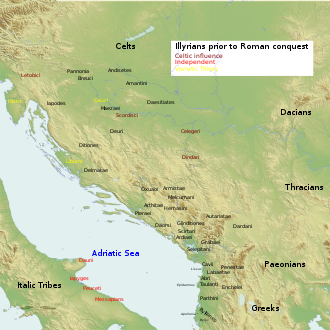Illyrian language
| Illyrian (†) | ||
|---|---|---|
| Period | approx. 2000 BC BC - AD 600 | |
|
Formerly spoken in |
Illyria (western part of the Balkan Peninsula ) | |
| Linguistic classification |
|
|
| Language codes | ||
| ISO 639 -1 |
- |
|
| ISO 639 -2 |
ine (other Indo-European languages) |
|
| ISO 639-3 |
xil |
|
The Illyrian language was spoken in ancient times by the Illyrian people and was an independent branch of the Indo-European languages . The distribution area largely coincided with the historical region of Illyria . The Messapier in Apulia (in present-day Italy ) may also speak an Illyrian dialect.
The Illyrian is only sparsely transmitted and hardly researched. We only know a few individual words as well as a few place and person names, which are mainly passed down on grave or building inscriptions.
traces
The Illyrian language has hardly left any written traces and is therefore particularly sparse. No whole Illyrian sentence has yet been found; therefore the only sources are a handful of words that have come down in Greek and Roman sources. In addition, several personal names have come down to us.
Individual words are known from Greek and Roman sources, e.g. B. sabaia 'beer-like drink', sybina 'hunting spit', mantia 'mulberry', rhinos 'fog, clouds', brisa 'vessel filled with grapes', tertigio 'trader' and bosona 'running water'. Many place and person names have also come down to us from Greek and Roman sources, e.g. B. Queen Teuta , the Kings Agron , Genthios , Glaukias , Bardyllis and Monunios and Illyrian places like Amantia , Lychnidos , Byllis , Ulpiana and others.
Practically nothing is known about Illyrian grammar; only that the Indo-European falls have been preserved is certain.
history
The Illyrian dialects probably emerged for the first time around the 2nd millennium BC. BC, maybe around 1200 BC When the Mycenaean palace centers in Greece collapsed. The language developed rather autochthonously in its regions ( Illyria ). Since the 6th century BC Greeks founded individual colonies in the area of the Illyrians (e.g. Dyrrachium , Apollonia or Lissus ), and since this century the ancient Greek language has influenced the Illyrian vocabulary.
In the 1st century BC The Romans began to conquer the Illyrian territories , first under Caesar (Illyrian-Roman War). The further history of the Illyrian language has not been clarified with certainty.
Possible relationship with Albanian
To this day it is controversial whether and to what extent the Albanian language is related to Illyrian. Such a connection was already assumed by Johann Georg von Hahn in his book Albanesian Studies , published in 1845 . The results of linguistic research in the 20th century speak partly for and partly against this assumption. According to Joachim Matzinger (2009), neither the parentage hypothesis nor the opposite hypothesis can be proven.
The assumption that Albanian is a daughter language of Illyrian corresponds to the hypothesis that a complete Romanization of the Illyrian language (s) did not take place and that the later Slavic immigration could not displace them either.
Supposedly Illyrian toponyms in Central Europe
In the first half of the 20th century, the theory of panillyrism was developed specifically in the historical linguistics and prehistory research of the German-speaking area . Based on the finding that many toponyms could not be assigned to the Celtic , Latin or later language classes, an Illyrian (mixed with the Venetian language of the ancient Venetians also Veneto-Illyrian ) language area was postulated that not only covers the Balkans, but also large parts Central Europe included. Although this theory and thus also the etymological explanations declared as Illyrian were already rejected as untenable in the academic world in the middle of the 20th century, they remained powerful in local literature in the period that followed. The existence of a pre-Celtic and pre-Roman Indo-European language layer in parts of Central Europe is still assumed, however, linguistics now operate in the Eastern Alps with terms such as Eastern Alpine Bloc or Eastern Alpine Indo-European , in Eastern Austria and Hungary with Pannonian .
literature
- Hans Krahe , The language of the Illyrians , 2 volumes, 1955 a. 1964
- Anton Mayer, The language of the old Illyrians , 2 volumes, 1957 a. 1959
- Ivan Duridanov, Thrakisch, Dakisch, Illyrisch , in: Handbuch der Südosteuropa-Linguistik , ed. v. Uwe Hinrichs, 1999 ( ISBN 3-447-03939-6 ), pp. 733-759
- The Cambridge encyclopedia of the World's ancient languages , ed. By Roger D. Woodard, 4th ed., 2005 ( ISBN 0-521-56256-2 ), p. 12 f.
Web links
- Entry on the Illyrian language in the Encyclopedia of the European East (PDF file; 147 kB)
Individual evidence
- ↑ Matzinger, Joachim (2009): The Albanians as descendants of the Illyrians from the perspective of historical linguistics , in: Schmitt, Oliver Jens (Ed.), Albanische Geschichte: Stand und Perspektiven der Forschung , Oldenbourg Verlag, pp. 13–36.
- ↑ Karl Kaus : The Illyrians and the “Illyrian Settlement” of Burgenland. Falsification of history, re-engagement or just ignorance? In: Burgenländische Heimatblätter , 71, 2009, pp. 81-102, digitized online at zobodat.at (PDF; 1 MB).
